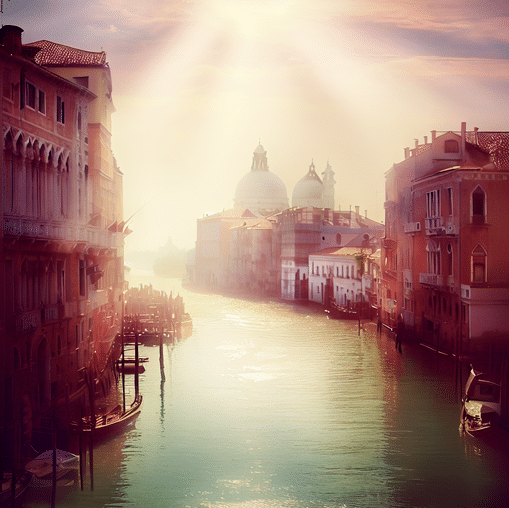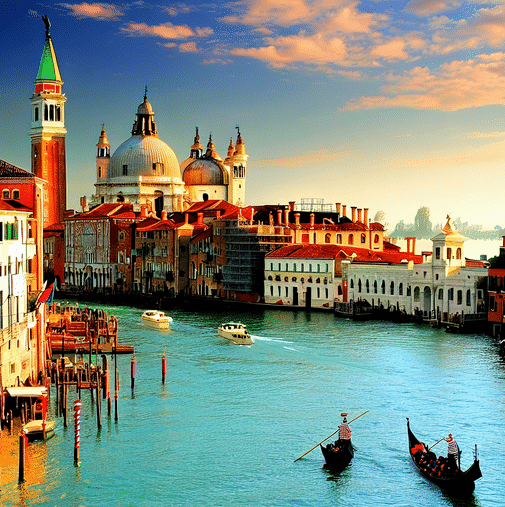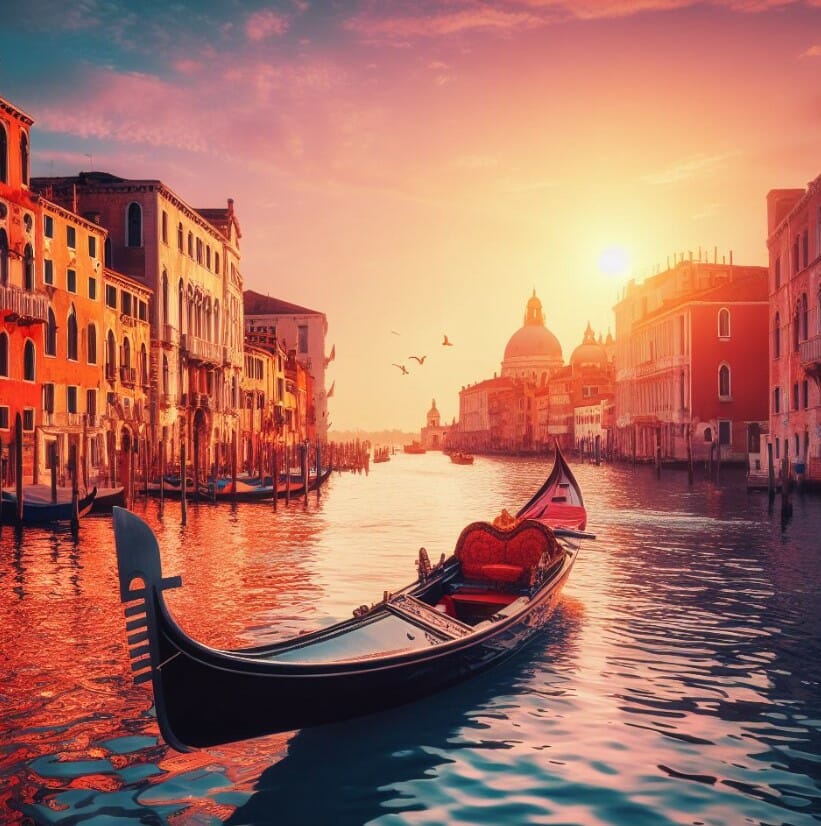Venice, often referred to as the “Floating City,” is renowned for its picturesque canals, stunning architecture, and rich history. However, in recent years, concerns have emerged regarding the city’s long-term stability. Is Venice sinking? Let’s delve into the science, the challenges, and the potential solutions surrounding this captivating city’s uncertain future.
Venice: A City Built on Water

To comprehend the gravity of the situation, it’s essential to understand Venice’s unique geographical and architectural characteristics. Founded over 1,500 years ago, Venice is an archipelago of 118 small islands, linked by an intricate network of canals and bridges. The city’s foundations are supported by wooden pilings, driven deep into the marshy soil, and topped with stone slabs.
The Sinking Truth: Subsidence and Rising Sea Levels
Venice’s precarious position is the result of two interconnected phenomena: subsidence and rising sea levels. Subsidence refers to the slow, gradual sinking of land, which in Venice’s case, can be attributed to both natural and human-induced factors. Over time, the sheer weight of the city’s buildings has caused the wooden pilings and underlying soil to compress, contributing to the city’s descent.
Additionally, the extraction of groundwater from underground aquifers, a practice that persisted until the 1960s, further accelerated the city’s subsidence. Although this practice has since been halted, Venice continues to sink at a rate of approximately 1-2 millimeters per year.
On the other hand, rising sea levels have become a more pressing concern due to climate change. As global temperatures increase, polar ice caps melt, and thermal expansion causes seawater to rise, Venice experiences more frequent and severe flooding. These high water events, known as “aqua alta,” pose a significant threat to the city’s infrastructure and cultural heritage.
Combating the Crisis: The MOSE Project
In response to the rising waters, the Italian government initiated the MOSE (Modulo Sperimentale Elettromeccanico) project in 2003. This ambitious endeavor aims to protect Venice and its lagoon from flooding by constructing a series of mobile barriers at the three main inlets connecting the Adriatic Sea to the lagoon. When raised, these barriers block incoming tidal surges, preventing high water from inundating the city.
Despite numerous setbacks, such as delays and cost overruns, the MOSE project has shown promising results in recent tests. However, critics argue that the system may only provide temporary relief and that more comprehensive, long-term solutions should be explored.
Looking Ahead: Preserving the Jewel of the Adriatic

The question, “Is Venice sinking?” can be answered with a resounding yes. However, the city’s precarious situation is not solely due to subsidence; rising sea levels pose an equally significant threat. The MOSE project, while potentially offering some respite, is unlikely to be a panacea for the city’s challenges.
Ultimately, preserving Venice for future generations will require a multi-faceted approach, encompassing innovative engineering solutions, stringent environmental policies, and global cooperation in combating climate change. The world must unite to protect this irreplaceable treasure, lest we lose one of humanity’s most enchanting and historically significant cities to the ravages of time and tide.
The Impact of Tourism on Venice’s Stability
While Venice’s sinking and rising sea levels are critical concerns, the impact of tourism on the city’s stability cannot be overlooked. Venice has long been a popular tourist destination, attracting millions of visitors each year. This influx of tourists places immense strain on the city’s infrastructure, resources, and environment.
The Weight of Mass Tourism
The sheer volume of tourists visiting Venice contributes to the city’s subsidence, as the additional weight puts pressure on the foundations and the wooden pilings. Moreover, the constant movement of people around the city accelerates the wear and tear of historic buildings, bridges, and other structures, further exacerbating the sinking issue.
The Cruise Ship Dilemma
Cruise ships bring thousands of tourists into the heart of Venice, navigating the narrow canals and creating large waves in their wake. These waves, known as “moto ondoso,” cause erosion of the canal banks and damage the foundations of buildings. In response to growing concerns, the Italian government has taken steps to limit the size and number of cruise ships entering Venice, although the long-term effectiveness of these measures remains to be seen.
Environmental Degradation
The influx of tourists also strains Venice’s environment, as increased traffic on waterways contributes to pollution and the degradation of water quality in the canals. Furthermore, the high demand for resources, such as water, energy, and waste disposal, places a significant burden on the city’s already fragile ecosystem.
Sustainable Tourism and the Future of Venice

To ensure the long-term survival of Venice, it’s crucial to promote sustainable tourism practices. This includes measures such as:
- Limiting the number of tourists: Implementing a cap on the number of visitors allowed in the city, particularly during peak seasons, can help reduce the strain on infrastructure and resources.
- Encouraging responsible travel: Educating tourists on the importance of preserving Venice’s cultural heritage, adopting eco-friendly practices, and supporting local businesses can help minimize the negative impact of tourism.
- Investing in sustainable infrastructure: Developing environmentally friendly transportation options, such as electric water taxis and improved public transport, can help reduce pollution and traffic congestion in the city.
- Preservation and restoration efforts: Effective conservation and restoration of historic buildings, monuments, and artworks can help safeguard Venice’s cultural treasures for future generations.
The future of Venice hinges on striking a delicate balance between embracing its status as a world-renowned tourist destination and preserving its unique cultural and environmental heritage. By adopting sustainable tourism practices and addressing the pressing issues of subsidence and rising sea levels, Venice can continue to captivate and enchant visitors for centuries to come.
What are some of the challenges of conserving historic buildings in Venice?
Conserving historic buildings in Venice presents a unique set of challenges due to the city’s distinct location, environmental factors, and architectural characteristics. Some of the key challenges in preserving Venice’s architectural treasures include:
- Subsidence and flooding: As previously discussed, Venice is affected by subsidence and rising sea levels, which contribute to the city’s gradual sinking. This results in increased exposure of historic buildings to floodwaters, leading to structural damage, erosion, and decay.
- Saltwater infiltration: Venice’s proximity to the sea and its network of canals expose the city’s buildings to saltwater. The infiltration of saltwater into the brick and stone structures can cause deterioration, as salt crystals expand and contract, leading to the weakening of the building materials.
- High groundwater levels: The high groundwater levels in Venice contribute to the dampness and humidity in the foundations and walls of historic buildings. This can lead to rotting of wooden elements, corrosion of metal reinforcements, and the growth of mold and algae, causing further damage to the structures.
- Maintenance and repair costs: The preservation and restoration of historic buildings in Venice can be a costly and time-consuming process. Accessing buildings in Venice is often more challenging due to the city’s layout, and specialized techniques and materials may be required to address the unique conservation issues. This can strain the financial resources of conservation organizations and local authorities.
- Regulations and bureaucracy: The process of obtaining permits and approvals for conservation work in Venice can be complex and time-consuming. Navigating the various regulations, coordinating with multiple authorities, and adhering to strict preservation guidelines can pose significant challenges for conservation projects.
- Impact of tourism: As mentioned earlier, the influx of tourists in Venice accelerates the wear and tear of historic buildings, bridges, and other structures. The constant flow of people and the increased pressure on infrastructure can hinder conservation efforts and exacerbate the city’s environmental issues.
- Climate change: The effects of climate change, such as rising temperatures, extreme weather events, and increased frequency of high water events, pose additional challenges to preserving Venice’s historic buildings. Climate change can exacerbate existing issues, such as subsidence and saltwater infiltration, making it even more difficult to protect the city’s architectural heritage.
Addressing these challenges requires a multifaceted approach, including innovative engineering solutions, sustainable tourism practices, and proactive environmental policies. By working together, local authorities, conservation organizations, and the global community can help protect Venice’s unique architectural legacy for generations to come.
What are some innovative engineering solutions that have been proposed to address these challenges?
Several innovative engineering solutions have been proposed and implemented to address the challenges faced by Venice in preserving its historic buildings and combating the effects of subsidence, flooding, and climate change. Some notable examples include:
- The MOSE Project: As previously mentioned, the MOSE (Modulo Sperimentale Elettromeccanico) project is a system of mobile barriers designed to protect Venice and its lagoon from flooding by blocking tidal surges at the three main inlets connecting the Adriatic Sea to the lagoon. While not without its controversies and setbacks, the MOSE project represents a significant engineering effort to mitigate the effects of rising sea levels.
- Building reinforcement and elevation: To safeguard historic buildings from flood damage, some proposals suggest reinforcing the existing foundations and elevating the structures. This can be achieved through techniques such as underpinning (strengthening the existing foundations) or by inserting additional layers of water-resistant materials beneath the buildings. In some cases, entire buildings have been lifted to a higher level to protect them from floodwaters.
- Waterproofing and moisture control: Innovative materials and techniques are being developed to waterproof the walls and foundations of historic buildings. This includes the use of water-resistant coatings, breathable membranes, and advanced drainage systems to prevent moisture infiltration and control humidity levels.
- Canal bank stabilization: Engineering solutions, such as the installation of sheet piling or the use of geotextiles, have been proposed to stabilize and reinforce the canal banks. These measures can help reduce erosion, protect the foundations of buildings, and prevent further subsidence.
- Sustainable urban planning: To address the long-term challenges faced by Venice, some proposals advocate for a more sustainable and holistic approach to urban planning. This includes the development of environmentally friendly transportation options (e.g., electric water taxis), improved waste and water management systems, and the integration of green spaces and natural flood defenses into the cityscape.
- Artificial islands and barriers: Another proposed solution to combat rising sea levels is the construction of artificial islands or barriers in the lagoon. These structures could help dissipate wave energy, reduce the impact of tidal surges, and provide additional space for housing and infrastructure.
- Monitoring and early warning systems: The use of advanced sensors, remote sensing technology, and data analysis can help monitor the ongoing subsidence, flooding, and environmental changes in Venice. This information can inform decision-making and enable the implementation of early warning systems to better prepare for and manage high water events.
These innovative engineering solutions, combined with sustainable tourism practices and proactive environmental policies, can play a crucial role in addressing the challenges faced by Venice and preserving its unique architectural and cultural heritage for future generations.
How much is Venice sinking per year?
Venice’s rate of subsidence has varied over time, and the sinking rate has slowed down significantly in recent decades. In the 20th century, Venice was sinking at a rate of about 1-2 millimeters per year. In the 1970s, the rate of subsidence was higher, partially due to the extraction of groundwater from underground aquifers, which was later stopped. As a result, the sinking rate has decreased.
Recent studies suggest that the current rate of sinking is roughly 1-2 millimeters per year. It is essential to note that this rate may not be uniform across the city, as some areas may experience higher or lower rates of subsidence. Additionally, the combined effects of subsidence and rising sea levels due to climate change exacerbate the city’s vulnerability to flooding and high water events.
What year will Venice be sunk by?
Predicting the exact year that Venice will be “sunk” is challenging due to the numerous variables involved. However, Venice has been gradually sinking for centuries, both due to natural subsidence (the slow sinking of the land) and human activities, such as the extraction of groundwater. In addition, the city is also at risk due to rising sea levels caused by climate change.
Recent measures like the MOSE (Modulo Sperimentale Elettromeccanico) project, which is a series of movable barriers designed to prevent flooding during high tides, have been implemented to protect the city. However, the efficacy and long-term viability of such measures are still being evaluated.
While Venice will likely continue to face increasing challenges from sea-level rise and subsidence, it’s hard to predict a specific year when the city will be “sunk.” It is more likely that over time, the city will experience more frequent and severe flooding, requiring continuous adaptations and interventions.
It’s also worth noting that the definition of “sunk” can vary. If by “sunk” one means submerged entirely and permanently, that’s a scenario that might be more distant. If, however, “sunk” refers to a situation where daily life becomes untenable due to persistent flooding or infrastructure challenges, that could occur sooner.
Conservation efforts, global initiatives to combat climate change, and innovative engineering solutions can all play a role in determining the fate of Venice in the coming decades.
